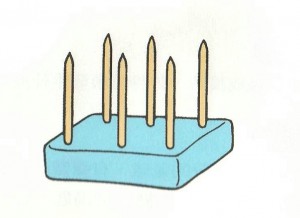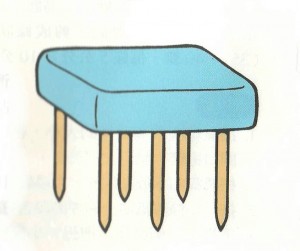![]() three body parts
three body parts
![]() three pairs of legs
three pairs of legs
Just remember this as the 3 + 3 rule.
Question:
With six legs, how many legs are needed for an insect to stand up?
You can use clay and toothpicks to model an insects legs and which legs are needed for balance.
Discover for Yourself
1. Shape a lemon-size piece of modeling clay into a rectangular shaped block.
2. Stick 3 toothpicks on each side of the clay block as shown. The toothpicks should stick out the same amount from the clay. The clay represents an insect’s body and the toothpicks represent its legs.
3. Turn the insect over and stand it on its 6 legs. Adjust the length of the legs if the insect wobbles.
4. Take any 3 of the toothpick legs out of the clay body, then try to stand the insect on its 3 remaining legs. If the insect falls, put the 3 legs back in.
5. Repeat step 5, taking out 3 other legs. Keep trying using a different combination until the clay insect can stand on 3 legs.

 |
Janice VanCleave’s Insects and Spiders: Mind-Boggling Experiments You Can Turn Into Science Fair Projects |
Result:The insect stands when the front leg and hind leg on one side and the middle leg on the opposite side are removed.
Why?
By lifting the middle leg on one side and the front leg and hind leg on the opposite side, the center of gravity of the clay insect does not change, or changes so little that the clay insect balances. When other legs are removed, the center of gravity of the body changes enough to cause the body to be off balance. Insects basically walk by moving the middle leg on one side and the front and hind leg on the opposite side. But unlike the clay insect, real insects can shift their weight so they can balance on other legs than can the clay model.
